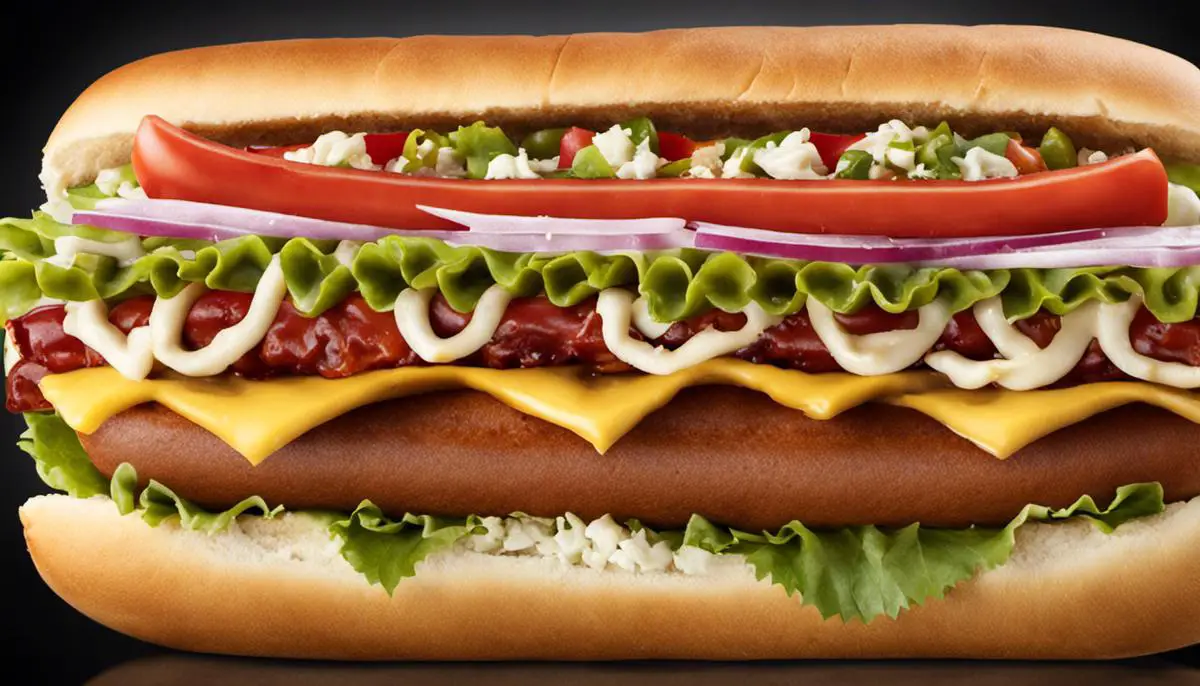The bustling streets of New York City are known for their vibrant food culture, featuring a multitude of international cuisines. Amongst this cosmopolitan culinary tapestry, the humble hot dog stands tall as a symbol of the City’s culinary heritage and conventional gusto. Particularly, the New York Style Hot Dog, with its unique blend of flavors, is deeply ingrained in the city’s fascinating street food scenario. This piece connects intriguing historical evidences, distinctive ingredients, cultural relevancies, and contemporary influence to narrate the captivating journey of the New York Style Hot Dog.
Table of Contents
Historical Origin of New York Style Hot Dog

Historical Origin of New York Style Hot Dog
The story of the New York style hot dog is deeply rooted in the multicultural history of the city’s immigrant population, particularly German immigrants. Towards the end of the 19th century, the German tradition of eating sausages with bread became an inexpensive meal for factory workers, who soon began to adopt a variation of the tradition using a bun and a frankfurter.
These frankfurter bun sandwiches were quickly picked up by food cart vendors for their convenience and affordability, and they quickly spread around the city’s densely populated areas. Hence, this method of consumption helped to shape the hot dog’s role as a quick and cheap meal in New York City add it gradually gained popularity among the city’s middle and lower-class populace.
Coney Island and the Hot Dog
The hot dog’s popularity soared when it reached the pleasure zones and beach resorts of Coney Island. The owner of Feltman’s German beer garden, Charles Feltman, is often credited with introducing the hot dog to Coney Island in 1867. He used a custom-made bun to offer a portable meal to the resort visitors.
The hot dog was an instant hit as a finger food among the Coney Island crowds. Feltman’s success was later emulated by Nathan Handwerker who, with his wife Ida, started Nathan’s Famous in 1916, a hot dog stand that still remains popular to this day. Nathan’s offered a flavorful hot dog at a lower price, solidifying the popularity of hot dogs on Coney Island.
Street Food Staple in New York
Through the 20th century, the hot dog became a primary staple of New York street food culture. Street vendors became a common sight on Manhattan’s bustling sidewalks, serving up hot dogs to customers on the go. These vendors added their own twists and flavors to the standard hot dog, creating a unique New York style.
The preparation involves grilling or steaming the sausage and serving it in a slightly toasted bun, typically topped with a spicy brown mustard, sauerkraut, and possibly grilled or fresh onions. Some variations even include a tangy tomato-based sauce.
When we think of New York’s diverse food culture and culinary identity, the New York style hot dog immediately springs to mind. This beloved food icon can be found anywhere in the Big Apple, from the hands of a street vendor to a stadium snack at a baseball game, and even served upscale in its most exquisite form in fancy restaurants.
The Unique Ingredients of a New York Style Hot Dog

Finding Distinction in the Sausage
The soul of the New York style hot dog lies in its signature all-beef sausage. It’s not just about the meat, but also the distinct sprinkle of garlic and paprika that gives it a standout flavor. But the uniqueness doesn’t stop at seasoning – the way the sausage is cooked is also vital. In contrast to other regional hot dogs that might be charcoal-grilled, boiled, or even steamed, New York style ones are always sizzled on a flat grill, creating a flavor depth like no other.
Traditional Toppings on a New York Style Hot Dog
A New York style hot dog is not complete without its traditional toppings. First among these toppings is a generous slathering of deli-style yellow mustard. This variety of mustard is specifically known for its bright yellow color and its smooth, tangy flavor which nicely complements the savory taste of the sausage.
Unlike other regional styles where a plethora of toppings is common, the New York style hot dog keeps it truly simple and classic with steamed onions. These onions are usually diced and cooked in a sauce made from tomato paste, corn syrup, corn starch, vinegar, and spices. The resulting combination is a sweet, tangy sauce that’s uniquely New York. Other optional toppings might include sauerkraut or a thin layer of sautéed bell peppers.
The Iconic Poppy Seed Bun
Another irreplaceable element of the New York style hot dog is the poppy seed bun. The bun is often steamed or heated before the sausage is placed onto it, which results in a bun that is warm and soft, yet sturdy enough to hold the sausage and toppings without falling apart. The addition of poppy seeds to the bun isn’t just about the textural contrast they add; indeed, their subtly sweet, nutty flavor also contributes to the overall taste of the New York style hot dog.
Why New York’s Signature Hot Dog Ingredients Have Endured
The timeless combination found in a New York style hot dog remains popular due to the complementary nature of each ingredient. These components form a distinct taste profile, balancing savory, tangy, and subtly sweet flavors. More than just a quick bite, a New York style hot dog carries a cultural significance and nostalgia. It epitomizes the rich history, diversity, and dynamism of New York City’s evolving culinary culture.
The Cultural Significance

The Tale of New York and Its Iconic Hot Dogs
In the bustling, ever-evolving city of New York, there’s one constant—a hot dog stand on every corner. Serving up quick, tasty, and affordable nourishment, these stands have become an integral part of the city’s dynamic lifestyle. More than just a meal, the hot dog is symbolic of New York’s relentless pace and vibrant culture.
Whether it’s the early morning commuter grabbing breakfast while on the run, or the night owl seeking a quick bite after hours, hot dog stands provide for all in an ever-awake city. These vendors epitomize New York’s 24/7 energy, a literal beacon of sustenance at all hours.
Beyond meeting daily dietary needs, the humble hot dog also bears witness to the city’s spirit of competition through events like the Nathan’s Hot Dog Eating Contest on Coney Island. Held annually since 1916, this spectacle attracts participants and spectators across the globe, all vying to claim the hot dog consumption title. Indisputably, the event has become a Fourth of July tradition, cementing the city’s love for hot dogs year after year.
The versatility of the New York style hot dog is also a symbol of New York’s character— its diversified appeal echoing the city’s melting pot philosophy. The hot dog adjusts to a diverse set of tastes, topped with classic mustard and sauerkraut for the traditionalists, or laden with gourmet toppings for the adventurous epicurean. It truly caters to every palate.
As the city has grown and changed, the New York style hot dog has remained an unchanging icon in the lives of its inhabitants. Like New York city itself, the hot dog stands as a monument to perseverance, adaptability, and the spirit of endurance.
New York-style Hot Dogs in Contemporary Cuisine

Evolution of the New York-style Hot Dog in Modern Culinary Arts
In the contemporary culinary sphere, the New York-style hot dog plays a crucial role in the city’s gastronomy. Its timeless appeal and historical significance inspire innovative takes on this classic dish, breathing new life into its renowned reputation.
Brought to life through culinary artistry, the New York-style hot dog has transformed from an ordinary street food item to a gourmet favorite. Its composition reflects the city’s cultural diversity, heavily influenced by the city’s immigrant population, notably those from Eastern Europe. This influence is clear in the widespread popularity of the hot dog and the German-inspired frankfurter at its core.
The classic New York-style hot dog’s defining feature is its natural casing, providing a satisfying ‘snap’ upon the first bite— a gastronomic experience sought by many. Prime quality beef and a fine balance of seasonings form the inner core, while a layer of slowly caramelized onions, marinated in a mildly sweet tomato-based sauce, adds unique flair. The finishing touch is a slather of tangy yellow mustard.
Modern food trends have seen the hot dog evolve into a base for creative culinary expression. Gourmet renditions proliferate with toppings such as truffle mayo, Korean kimchi, and even opulent sprinkles of gold leaf. Both restaurant chefs and hot dog cart vendors continually reimagine the New York-style hot dog to entice culinary explorers.
Fusion versions rise in popularity, showcasing the adaptability of this simple dish. They represent New York cuisine’s multicultural nature, with toppings ranging from Mexican influences like jalapeños and guacamole to Asian elements of soy glaze and seaweed strips.
Throughout these modern developments, the classic New York-style hot dog maintains its charm, adapting to shifting food trends while staying true to its roots. Its essence remains the same: an edible tribute to New York’s vibrant diversity and history. From city parks to street vendors, upscale restaurants to neighborhood BBQs, the New York-style hot dog is a beloved icon of the city’s food culture.

Reflecting on the journey of the New York Style Hot Dog, one realizes it’s not just a street food but an enduring culinary icon of New York City. Its rich history, tradition ingrained ingredients, and cultural significance speaks volumes about the City’s vibrant heritage and its people’s preference over the years. Despite the swirl of gourmet interpretations and fusion experiments in the contemporary food world, the magic of the New York-Style hot dog continues to be quintessential, firmly holding its own. As the aroma of a freshly setup hot dog stand continues to waft down a busy New York street, it becomes clear that the city’s penchant for this delicious fare is unwavering, and it will always remain the steadfast symbol of New York’s intricate food culture.
Related Reading
Master Hot Dog Grilling Techniques at Home
Master the Grill: 7 Essential Hot Dog Grilling Tips for the Perfect BBQ



